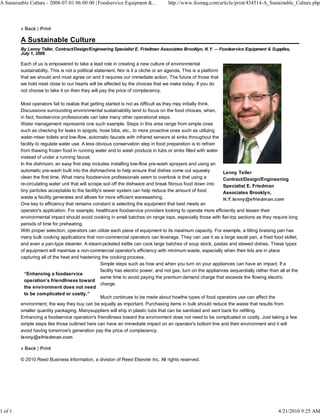More Related Content
Similar to A Sustainable Culture - 200.. (20)
A Sustainable Culture - 200..
- 1. Lenny Teller
Contract/Design/Engineering
Specialist E. Friedman
Associates Brooklyn,
N.Y.lenny@efriedman.com
“Enhancing a foodservice
operation’s friendliness toward
the environment does not need
to be complicated or costly.”
« Back | Print
A Sustainable Culture
By Lenny Teller, Contract/Design/Engineering Specialist E. Friedman Associates Brooklyn, N.Y. -- Foodservice Equipment & Supplies,
July 1, 2008
Each of us is empowered to take a lead role in creating a new culture of environmental
sustainability. This is not a political statement. Nor is it a cliché or an agenda. This is a platform
that we should and must agree on and it requires our immediate action. The future of those that
we hold most close to our hearts will be affected by the choices that we make today. If you do
not choose to take it on then they will pay the price of complacency.
Most operators fail to realize that getting started is not as difficult as they may initially think.
Discussions surrounding environmental sustainability tend to focus on the food choices, when,
in fact, foodservice professionals can take many other operational steps.
Water management represents one such example. Steps in this area range from simple ones
such as checking for leaks in spigots, hose bibs, etc., to more proactive ones such as utilizing
water-miser toilets and low-flow, automatic faucets with infrared sensors at sinks throughout the
facility to regulate water use. A less obvious conservation step in food preparation is to refrain
from thawing frozen food in running water and to wash produce in tubs or sinks filled with water
instead of under a running faucet.
In the dishroom, an easy first step includes installing low-flow pre-wash sprayers and using an
automatic pre-wash built into the dishmachine to help ensure that dishes come out squeaky
clean the first time. What many foodservice professionals seem to overlook is that using a
re-circulating water unit that will scrape soil off the dishware and break fibrous food down into
tiny particles acceptable to the facility's sewer system can help reduce the amount of food
waste a facility generates and allows for more efficient warewashing.
One key to efficiency that remains constant is selecting the equipment that best meets an
operator's application. For example, healthcare foodservice providers looking to operate more efficiently and lessen their
environmental impact should avoid cooking in small batches on range tops, especially those with flat-top sections as they require long
periods of time for preheating.
With proper selection, operators can utilize each piece of equipment to its maximum capacity. For example, a tilting braising pan has
many bulk cooking applications that non-commercial operators can leverage. They can use it as a large sauté pan, a fried food skillet,
and even a pan-type steamer. A steam-jacketed kettle can cook large batches of soup stock, pastas and stewed dishes. These types
of equipment will maximize a non-commercial operator's efficiency with minimum waste, especially when their lids are in place
capturing all of the heat and hastening the cooking process.
Simple steps such as how and when you turn on your appliances can have an impact. If a
facility has electric power, and not gas, turn on the appliances sequentially rather than all at the
same time to avoid paying the premium demand charge that exceeds the flowing electric
charge.
Much continues to be made about howthe types of food operators use can affect the
environment; the way they buy can be equally as important. Purchasing items in bulk should reduce the waste that results from
smaller quantity packaging. Manysuppliers will ship in plastic tubs that can be sanitized and sent back for refilling.
Enhancing a foodservice operation's friendliness toward the environment does not need to be complicated or costly. Just taking a few
simple steps like those outlined here can have an immediate impact on an operator's bottom line and their environment and it will
avoid having tomorrow's generation pay the price of complacency.
lenny@efriedman.com
« Back | Print
© 2010 Reed Business Information, a division of Reed Elsevier Inc. All rights reserved.
A Sustainable Culture - 2008-07-01 06:00:00 | Foodservice Equipment &... http://www.fesmag.com/article/print/434514-A_Sustainable_Culture.php
1 of 1 4/21/2010 9:25 AM
